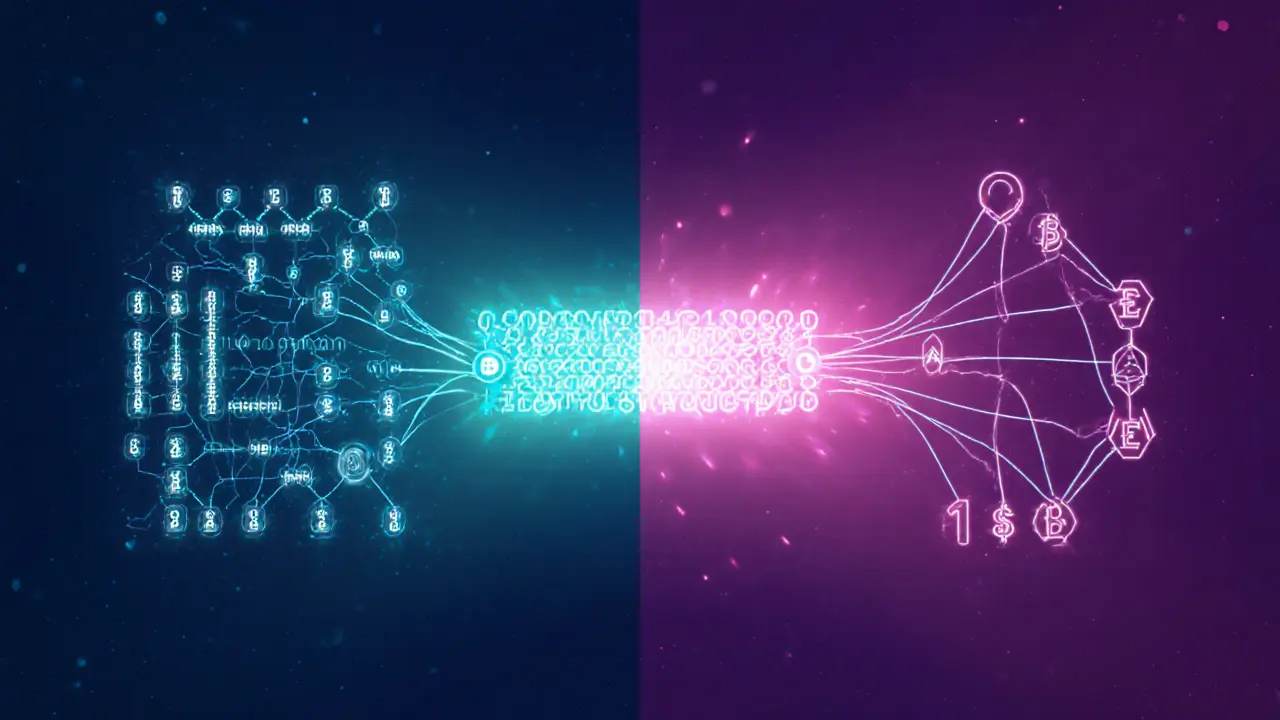May 19, 2025, Posted by: Ronan Caverly

Merkle Tree Proof Calculator
Bitcoin uses a binary Merkle tree to prove transaction inclusion. Proof size grows logarithmically with number of transactions.
Ethereum uses a Merkle-Patricia Trie to prove account/state inclusion. Proof size depends on state depth.
Enter values and click calculate to see proof sizes.
How It Works
Bitcoin Merkle proofs require ⌈log₂(N)⌉ hashes where N is the number of transactions.
Ethereum proofs typically involve 6-8 nodes for account state verification.
TL;DR
- Merkle Trees let Bitcoin verify a single transaction with just a few hashes.
- Ethereum upgrades the idea with a Merkle‑Patricia Trie to store accounts, contracts and receipts.
- Bitcoin’s proof size grows with log₂(num‑tx), Ethereum’s tries grow with state size.
- SPV wallets on Bitcoin rely on Merkle proofs; Ethereum dApps use trie proofs for state reads.
- Both systems cut bandwidth and storage, but Ethereum trades more computation for richer functionality.
When you hear the term Merkle Trees, you’re really hearing about the backbone that makes blockchains both trustworthy and lightweight. In Bitcoin, they enable a tiny mobile wallet to prove a payment without downloading the whole ledger. In Ethereum, they evolve into a Merkle‑Patricia Trie that can prove not just a payment but the entire state of a smart contract. This article walks through the math, the data structures, and the real‑world impact of these two approaches, ending with a side‑by‑side comparison you can reference when choosing a platform for your next project.
Merkle Tree is a binary hash tree where each leaf holds the hash of a data block and each parent stores the hash of its two children concatenated together. Invented by Ralph Merkle in 1988, the structure allows anyone to verify a single leaf by recomputing only the hashes along the path to the root. The root hash then serves as a compact commitment to the entire dataset. Bitcoin is a peer‑to‑peer digital cash system that records transactions in blocks chained together by proof‑of‑work. Bitcoin’s block header contains six fields, one of which is the Merkle root. Light clients-called Simple Payment Verification (SPV) nodes-download only these headers and a few proof elements to confirm that a transaction is included in a block. Simple Payment Verification is a method that allows a client to verify a transaction’s inclusion by checking a Merkle proof against the block’s Merkle root. The client needs three pieces of data: the transaction hash, the sibling hash at each tree level, and the block header’s Merkle root. With about log₂(N) hashes-where N is the number of transactions-validation is near‑instant. Block Header is a 80‑byte structure that records version, previous block hash, Merkle root, timestamp, difficulty target, and nonce. Because the header is small, SPV wallets can keep a copy of the longest chain without storing every transaction. Ethereum is a Turing‑complete blockchain platform that supports smart contracts, decentralized applications and a mutable global state. Ethereum replaces the simple Merkle tree with a Merkle‑Patricia Trie (MPT), a hybrid of a radix tree and a Merkle tree. The MPT can store arbitrary key‑value pairs while still providing cryptographic proof of any leaf. Merkle Patricia Trie is a data structure that combines a Merkle hash tree with a Patricia (compact prefix) trie, enabling efficient storage and verification of key‑value mappings. Ethereum maintains four distinct tries per block:- State Trie: maps each account address to its balance, nonce, storage root and code hash.
- Transaction Trie: stores each transaction’s RLP‑encoded data keyed by its index.
- Receipt Trie: holds transaction receipt data, never updated after block finalisation.
- Storage Tries: one per contract, storing the contract’s internal key‑value store.
Because the trie is keyed by the keccak256 hash of the path, any change-say, a balance update-only rewrites the nodes along that path, leaving the rest untouched. The new root hash becomes part of the block header, guaranteeing the integrity of the entire state.
Why Merkle Trees Matter for Blockchain Scalability
Both Bitcoin and Ethereum rely on Merkle‑based proofs to keep data transmission low. In a typical Bitcoin block with ~500 transactions, you need just 9 hashes (⌈log₂500⌉) to prove inclusion. Even a gigantic block with one million transactions requires only 20 hashes. For mobile wallets with megabytes of bandwidth, that reduction is decisive.
Ethereum’s MPT adds a layer of complexity. Proving that an account has a certain balance may involve traversing a path of around 6‑8 nodes, each containing a hash, a key fragment, and a value. The proof size is larger than Bitcoin’s, but it carries far more context-account nonce, storage root, and code hash-enabling dApps to read state without a full node.
Step‑by‑Step: Verifying a Bitcoin Transaction with SPV
- Obtain the transaction’s raw bytes and compute its double‑SHA256 hash.
- Request from a full node the list of sibling hashes that sit next to your hash at each tree level.
- Iteratively concatenate your hash with its sibling (left‑to‑right order), hash the pair, and repeat until you reach the root.
- Compare the resulting root with the Merkle root stored in the block header you already trust.
If the numbers match, the transaction is undeniably part of that block. No need to download the other 499 transactions.

Step‑by‑Step: Proving an Ethereum Account Balance
- Take the account address, hash it with keccak256, and split it into 32‑byte nibbles.
- Follow the nibbles down the State Trie, collecting the hash of each visited node.
- When you reach the leaf, you’ll see the RLP‑encoded account data (balance, nonce, storageRoot, codeHash).
- Combine the collected node hashes to reconstruct the state root. Verify that this root matches the one in the block header.
This proof can be sent to any light client, enabling it to read balances, token holdings or contract storage without syncing the whole chain.
Bitcoin vs Ethereum: Direct Comparison
| Feature | Bitcoin Merkle Tree | Ethereum Merkle‑Patricia Trie |
|---|---|---|
| Primary purpose | Transaction inclusion proof | Full state & contract storage verification |
| Data structure type | Binary hash tree | Patricia trie + Merkle hashing |
| Proof size (average block) | ≈9 hashes (500 tx) | 6‑8 nodes per account proof |
| Impact on light clients | Enables SPV wallets | Enables state‑reading dApps & light sync |
| Computational cost | Low (hash concat) | Higher (RLP decoding, trie traversal) |
| Storage requirement | Only block headers (~80bytes each) | Headers + trie nodes (≈1‑2GB for full sync) |
| Typical use‑case | Payment verification | Smart contract state queries, airdrop proofs |
Real‑World Applications Beyond Payments
Developers love Merkle proofs for airdrops. By storing a single root hash on‑chain, an issuer can let each recipient generate a proof off‑chain and claim tokens without the contract having to store every address. JavaScript libraries like merkletreejs work with keccak256 to build those trees in minutes.
Git, BitTorrent and IPFS also rely on Merkle structures to guarantee file integrity across distributed peers. The same guarantees that make a Bitcoin transaction tamper‑proof also protect a software repository’s history.
Future Directions: Verkle Trees and Beyond
Researchers are already eyeing Verkle trees-a vector‑commitment variant that can shrink proof sizes from dozens of kilobytes to a few hundred bytes. For Ethereum, this could mean faster sync times and cheaper on‑chain verification, while Bitcoin might see smaller Merkle proofs for future scaling solutions like Bitcoin Taproot’s script path spends.
As transaction volumes climb and smart contracts become more sophisticated, the pressure to keep proofs tiny while preserving security will only increase. The core idea remains the same: a succinct cryptographic commitment that anyone can verify with minimal data.

Frequently Asked Questions
What is a Merkle proof?
A Merkle proof is a list of sibling hashes that, when combined with the target leaf hash, reproduces the Merkle root stored in a block header. Matching the computed root with the on‑chain root proves that the leaf belongs to the dataset.
Why does Ethereum use a Patricia trie instead of a plain Merkle tree?
A Patricia trie compresses long paths of empty branches, reducing the number of nodes needed to store sparse key‑value maps like account balances. Combining this with Merkle hashing gives cryptographic guarantees while keeping storage reasonable for a state that can hold millions of accounts.
Can I use Merkle proofs on a mobile wallet?
Yes. Light Bitcoin wallets (SPV) rely on Merkle proofs to verify payments without downloading the whole blockchain. Ethereum light clients use similar trie proofs to read contract state.
How large is a typical Merkle proof in Bitcoin?
For a block with 500 transactions, a proof contains about nine 32‑byte hashes, roughly 288bytes total. Even a block with 1million transactions needs only around 20 hashes.
What tools help me build Merkle trees for airdrops?
JavaScript libraries like merkletreejs paired with keccak256 let you create leaf nodes from encoded address‑balance pairs, generate the root hash for on‑chain storage, and export individual proofs for users to claim tokens.
Write a comment
Comments
Jeannie Conforti
Hey folks, just wanted to say the Bitcoin Merkle tree is super easy to grasp once you think of it like a binary ladder that halves the data each step. It’s neat how the proof size only grows with log2 of the tx count, so even huge blocks stay lightweight. If you’re building a light client, this simplicity is a huge win.
May 19, 2025 AT 02:46
tim nelson
I get why people love the clarity of Bitcoin’s Merkle proofs – they’re deterministic and you can verify a single transaction without pulling the whole block. Ethereum’s trie adds flexibility for state, but it does cost a bit more in complexity. Both approaches have their sweet spots depending on the use case.
May 19, 2025 AT 03:36
Zack Mast
Contemplating the Merkle‑Patricia structure, one sees a microcosm of ordered chaos, a tree where each node carries the weight of account balances and storage roots. It mirrors society: intertwined, yet each element retains identity. The proof depth, often six to eight nodes, reminds us that even in complexity, a few steps suffice to unveil truth.
May 19, 2025 AT 04:26
Dale Breithaupt
Quick heads‑up: the binary Merkle in Bitcoin is lightning fast for inclusion proofs. Ethereum’s trie is more flexible for state queries, but expect a few extra hops. Pick the tool that matches your bandwidth.
May 19, 2025 AT 05:16
Rasean Bryant
Great breakdown! Just a reminder that for developers, the Bitcoin model is perfect for SPV wallets, while Ethereum’s model shines when you need to verify contract state without full nodes.
May 19, 2025 AT 06:06
Angie Food
i think the whole thing is overrated, u can just trust the miners lol. these proof sizes dont matter when the whole network is rigged kinda.
May 19, 2025 AT 06:23
Jonathan Tsilimos
While appreciating the contrarian view, it is essential to underscore that the integrity of a decentralized ledger fundamentally relies on cryptographic proofs rather than blind trust. The Merkle‑Patricia trie, despite its apparent complexity, offers provable state transitions that are audit‑ready.
May 19, 2025 AT 06:40
jeffrey najar
Let me dive a bit deeper into why these structures matter for developers and end‑users alike. First, the binary Merkle tree used by Bitcoin is astonishingly efficient: each hash you compute halves the remaining data, meaning you only need ⌈log₂(N)⌉ hashes to verify a transaction. This property makes Simplified Payment Verification (SPV) wallets both lightweight and secure, as they can trust block headers without downloading full blocks. Second, the Merkle‑Patricia trie in Ethereum, while more intricate, excels at state representation. Each node in the trie encodes not just balances but also contract storage, enabling developers to query any account’s state with a deterministic proof. The typical proof involves six to eight nodes, which is still acceptable for many applications, especially when you consider the richness of the data you gain. Third, the trade‑off between proof size and data richness is crucial: Bitcoin’s proofs are tiny but only confirm transaction inclusion; Ethereum’s proofs are larger but can confirm complex state changes, which is essential for decentralized finance (DeFi) interactions. Fourth, from a security standpoint, both structures are anchored in cryptographic hash functions (SHA‑256 for Bitcoin, Keccak‑256 for Ethereum), ensuring tamper resistance. Fifth, the deterministic nature of these trees allows for fast verification on low‑power devices, fostering wider adoption. Sixth, developers can leverage libraries like Bitcoin‑JS or ethers.js to handle proof generation without reinventing the wheel, simplifying integration. Seventh, understanding these differences helps engineers choose the right tool: use Bitcoin’s Merkle for simple payment verification, and Ethereum’s trie when you need to audit contract state. Eighth, as the ecosystem evolves, hybrid solutions may emerge, combining the best of both worlds for cross‑chain verification. Ninth, keep an eye on upcoming EIP‑4844, which aims to optimize data availability and could affect how proofs are constructed on Ethereum. Tenth, for academic curiosity, the mathematical foundations of Merkle trees trace back to Ralph Merkle’s 1979 work, showing how timeless these concepts are. Eleventh, remember that proof size impacts bandwidth costs, especially on mobile networks, so always profile your use case. Twelfth, in practice, the proof generation step is often off‑loaded to full nodes or dedicated services, keeping client code lean. Thirteenth, testing your verification logic against known vectors is essential to avoid subtle bugs. Fourteenth, keep your cryptographic libraries up‑to‑date, as vulnerabilities can emerge over time. Fifteenth, finally, the community’s open‑source contributions continue to improve tooling, so stay engaged with the repo ecosystems for the latest optimizations.
May 19, 2025 AT 07:13
Rochelle Gamauf
While the exposition is thorough, one must question whether such granular proof mechanisms truly serve the average user, or merely satiate the academic elite. The layered complexity might alienate newcomers, fostering a barrier to entry that contradicts the ethos of decentralization.
May 19, 2025 AT 08:03
Jerry Cassandro
I agree with the point about accessibility. In practice, most wallet developers abstract these details away, but it's still valuable for us to understand the underlying proofs for security audits.
May 19, 2025 AT 08:20
Parker DeWitt
Honestly, all this talk about Merkle trees is just a distraction from the real issue: the centralization of mining pools. No amount of clever proof structures can hide the fact that power is concentrated.
May 19, 2025 AT 09:10
Allie Smith
Nice summary, really helpful.
May 19, 2025 AT 09:26
Lexie Ludens
Wow, you really think this is the be‑all‑and‑end of blockchain security? While Merkle proofs are elegant, they’re just one layer in a massive onion of assumptions. What about the underlying consensus mechanism? Or the possibility that a malicious node could feed you a bogus proof if you’re not checking the root hash against a trusted source? It feels like you’re putting the cart before the horse, focusing on proofs while ignoring the bigger picture of network health.
May 19, 2025 AT 09:43
Aaron Casey
Bringing a cultural lens, the adoption of these proof systems varies worldwide. In regions with limited bandwidth, Bitcoin’s succinct proofs are advantageous, whereas Ethereum’s richer state proofs can empower complex DeFi ecosystems where data availability isn’t as constrained.
May 19, 2025 AT 10:33
Leah Whitney
That’s a solid point, especially for developers targeting emerging markets. Knowing the trade‑offs helps tailor the user experience.
May 19, 2025 AT 10:50
Lisa Stark
From a philosophical standpoint, the Merkle tree embodies the principle of minimalism-proving inclusion with the least amount of data. The trie, on the other hand, embraces comprehensiveness, reflecting the blockchain’s broader ambition to capture state.
May 19, 2025 AT 11:40
Logan Cates
But hey, maybe the whole thing is a hoax. Who trusts a system where a few guys can rewrite history if they control enough hash power? The proofs don’t matter if the chain itself is compromised.
May 19, 2025 AT 11:56
Shelley Arenson
👍 Good insights! Thanks for sharing.
May 19, 2025 AT 12:46
Joel Poncz
I totally get where you’re coming from, and it’s cool to see the community dissect these details. Keep the discussions going!
May 19, 2025 AT 13:03
Kris Roberts
Stepping back, both structures illustrate how cryptography can enable trustless verification, a hallmark of the decentralized vision.
May 19, 2025 AT 13:53
lalit g
Indeed, the technical elegance is impressive, yet we must also consider the human factor-education and accessibility are key for broader adoption.
May 19, 2025 AT 14:10
Reid Priddy
Honestly, these explanations are just smoke and mirrors. The real agenda is to keep users in the dark while the elite profit.
May 19, 2025 AT 15:00
Shamalama Dee
Let’s keep the conversation constructive and focus on how we can improve transparency for everyone.
May 19, 2025 AT 15:16
scott bell
What’s fascinating is how the community continuously refines these proofs, pushing the boundaries of what’s possible in lightweight verification. The synergy between academic research and open‑source implementation drives real progress.
May 19, 2025 AT 16:06
vincent gaytano
Sure, but don’t forget that every new optimization could also open a backdoor. Trust, but verify… and maybe stay skeptical.

Author
Ronan Caverly
I'm a blockchain analyst and market strategist bridging crypto and equities. I research protocols, decode tokenomics, and track exchange flows to spot risk and opportunity. I invest privately and advise fintech teams on go-to-market and compliance-aware growth. I also publish weekly insights to help retail and funds navigate digital asset cycles.